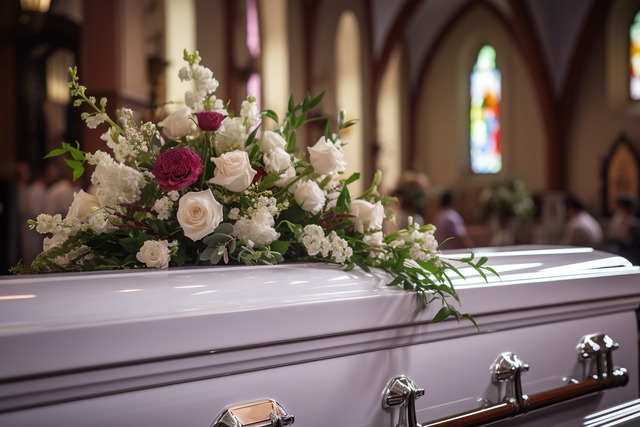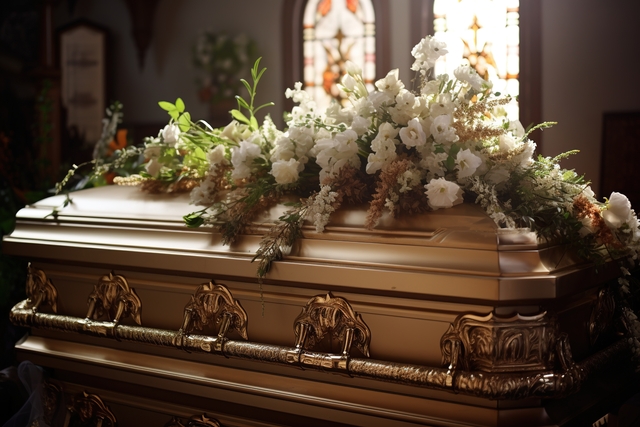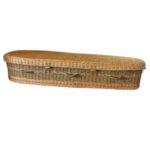
When it comes to planning a funeral, one of the most significant decisions you’ll face is choosing the right casket. The casket not only serves as the final resting place for your loved one but also represents a profound symbol of the respect and love you have for them. With so many options available, it’s essential to understand the different types of caskets, including their materials, styles, and features, to make an informed choice that honors the memory of your loved one.
Caskets are made from a variety of materials, each offering its own unique qualities. The material you choose can reflect personal preferences, cultural traditions, and budget considerations. Here’s a look at the most common materials used in casket construction:
1. Wood Caskets
Wood caskets are a popular choice due to their timeless beauty and natural warmth. They are available in various wood types, ranging from softwoods like pine and poplar to hardwoods like oak, maple, mahogany, and cherry. Hardwood caskets tend to be more expensive due to the quality and durability of the wood, while softwood options offer a more affordable alternative without compromising on aesthetics.
Each wood type has its own distinct grain pattern, color, and finish, allowing families to choose a casket that reflects their loved one’s personality or preferences. For instance, mahogany caskets are known for their rich, deep color and luxurious appeal, while pine offers a lighter, more rustic look.

“Wood caskets are a common choice amongst many and offer a wide variety of options in the materials, colors and types of wood.”
2. Metal Caskets
Metal caskets are highly durable and offer a sleek, modern appearance. They are typically constructed from materials like steel, stainless steel, bronze, or copper. The thickness of the metal, measured in gauges, determines the casket’s durability—the lower the gauge, the thicker and stronger the metal.
- Steel Caskets: These are the most commonly used metal caskets and come in various gauges, with 18-gauge and 20-gauge being the most popular. Steel caskets can be finished with a variety of colors and coatings, offering a range of aesthetic options.
- Stainless Steel Caskets: Known for their resistance to rust and corrosion, stainless steel caskets provide a blend of strength and elegance. They are a popular choice for those looking for durability without the higher cost of precious metals.
- Bronze and Copper Caskets: These caskets are made from precious metals and are often considered the most durable and elegant options available. Bronze and copper are naturally resistant to rust and corrosion, making them ideal for long-term preservation. These caskets are often chosen for their beauty and the lasting protection they offer.

“Some types of caskets come in various metals. From stainless steel caskets to even bronze caskets or copper. These types of caskets offer longevity and durability to stand the test of time.”
3. Eco-Friendly Caskets
As more people seek sustainable funeral options, eco-friendly caskets (aff) have gained popularity. These caskets are made from biodegradable materials like bamboo, wicker, seagrass, or cardboard. They are designed to break down naturally over time, making them a suitable choice for green burials or environmentally conscious families.
Eco-friendly caskets are often handcrafted and have a simple, natural appearance. While they may lack the ornate details of traditional caskets, they offer a meaningful way to honor a loved one’s commitment to environmental preservation.
Casket Styles
In addition to the material, the style of the casket is another crucial factor to consider. Casket styles can range from traditional to modern, and the choice often depends on personal preferences or cultural customs.
1. Traditional Caskets
Traditional caskets are typically rectangular with a hinged lid that can be opened in two parts. They often feature detailed craftsmanship, including raised panels, sculpted corners, and decorative handles. Traditional caskets can be made from wood or metal and are available in a wide range of finishes and colors.
These caskets are often chosen for their classic appearance and the sense of dignity they convey. They are suitable for both open and closed casket ceremonies.
2. Contemporary Caskets
Contemporary caskets offer a modern take on the traditional design, often featuring clean lines and minimalist details. They are available in a variety of materials, including wood and metal, and may include unique features like custom paint colors, personalized engravings, or unconventional shapes.
Contemporary caskets are ideal for families looking to create a distinctive and personalized tribute that reflects their loved one’s individuality.
3. Ornate Caskets
For those who desire an elaborate and luxurious final resting place, ornate caskets are an excellent option. These caskets often feature intricate carvings, inlays, and embellishments, such as velvet interiors, gold accents, and detailed moldings. Ornate caskets are typically made from high-quality materials like mahogany or bronze and are designed to make a grand statement.
While ornate caskets tend to be more expensive, they offer a level of craftsmanship and detail that is unmatched, making them a fitting choice for those who want to honor their loved one with a truly remarkable memorial.
4. Cremation Caskets
Cremation caskets are designed specifically for cremation purposes. They are typically made from lightweight materials like wood, fiberboard, or cardboard, and are free from metal components. While cremation caskets are often simpler in design, they are still available in a range of styles and finishes to suit different preferences.
Some cremation caskets are also suitable for viewing ceremonies, providing an opportunity for loved ones to say their final goodbyes before the cremation process.
Features to Consider
When choosing a casket, there are several additional features to consider that can enhance its functionality and personalization. Here are some common features to keep in mind:
1. Gasketed vs. Non-Gasketed Caskets
A gasketed casket, also known as a sealed casket, includes a rubber gasket along the lid that creates an airtight seal when closed. This feature is intended to protect the casket’s contents from external elements like moisture, air, and insects. While gasketed caskets offer additional protection, they are generally more expensive than non-gasketed options.
Non-gasketed caskets do not include this seal and are often chosen for their lower cost and simplicity.
2. Interior Lining
The interior lining of a casket adds a layer of comfort and elegance. Common materials used for the lining include velvet, crepe, and satin. Families can choose from various colors and patterns to create a personalized and comforting environment for their loved one.
Some caskets also offer additional padding or quilting to enhance the softness of the interior.

“To the left is an example of a casket decorated for a military funeral service.”
3. Personalization Options
Many casket manufacturers offer customization options that allow families to create a truly unique memorial. Personalization options may include:
- Engraving: Adding the loved one’s name, dates, or a meaningful message to the casket. These are personalized tributes to add meaning and memorialization to your casket.
- Custom Interiors: Selecting a specific fabric or pattern for the interior lining that reflects the deceased’s personality or interests.
- Themed Caskets: Choosing a casket with a design or color scheme that aligns with the loved one’s hobbies, passions, or cultural background.
4. Casket Handles
Casket handles are an often-overlooked feature, but they play a significant role in the overall appearance and functionality of the casket. Handles can be made from wood, metal, or plastic and may include decorative elements like carvings or engravings.
Some caskets offer swing bar handles that pivot, making it easier for pallbearers to carry the casket during the funeral procession.
Conclusion
Selecting the right casket is a deeply personal decision that involves careful consideration of materials, styles, and features. Whether you’re drawn to the timeless elegance of a wood casket, the durability of a metal casket, or the simplicity of an eco-friendly option, understanding the different types of caskets available can help you make a choice that honors your loved one’s memory.
By taking the time to explore the various options and features, you can ensure that the casket you choose is a fitting tribute to your loved one’s life and legacy.














